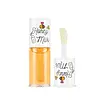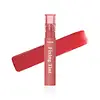What's inside
What's inside
 Key Ingredients
Key Ingredients

 Benefits
Benefits

 Concerns
Concerns

 Ingredients Side-by-side
Ingredients Side-by-side

Polybutene
Diisostearyl Malate
EmollientHydrogenated Polyisobutene
EmollientTridecyl Trimellitate
EmollientSilica Silylate
EmollientSilica Dimethyl Silylate
EmollientParfum
MaskingDehydroacetic Acid
PreservativePolyglyceryl-2 Triisostearate
EmulsifyingCI 19140
Cosmetic ColorantCI 15985
Cosmetic ColorantTocopheryl Acetate
AntioxidantMilk Protein Extract
Honey Extract
Humectant1,2-Hexanediol
Skin ConditioningPhenoxyethanol
PreservativeEthylhexylglycerin
Skin ConditioningPolybutene, Diisostearyl Malate, Hydrogenated Polyisobutene, Tridecyl Trimellitate, Silica Silylate, Silica Dimethyl Silylate, Parfum, Dehydroacetic Acid, Polyglyceryl-2 Triisostearate, CI 19140, CI 15985, Tocopheryl Acetate, Milk Protein Extract, Honey Extract, 1,2-Hexanediol, Phenoxyethanol, Ethylhexylglycerin
Water
Skin ConditioningIsododecane
EmollientDimethicone
EmollientVinyl Dimethicone/Methicone Silsesquioxane Crosspolymer
Butylene Glycol
HumectantDisteardimonium Hectorite
StabilisingTricalcium Phosphate
AbrasiveDimethicone/Vinyl Dimethicone Crosspolymer
Skin ConditioningSorbitan Isostearate
EmulsifyingLauryl Polyglyceryl-3 Polydimethylsiloxyethyl Dimethicone
Skin ConditioningDiisostearyl Malate
EmollientDiglycerin
HumectantCetyl PEG/PPG-10/1 Dimethicone
EmulsifyingStearyl Dimethicone
EmollientMagnesium Sulfate
Diphenylsiloxy Phenyl Trimethicone
Skin ConditioningPropylene Carbonate
SolventCI 77891
Cosmetic ColorantCI 15850
Cosmetic ColorantPolyglyceryl-3 Diisostearate
EmulsifyingOctadecene
SolventAcrylates/Polytrimethylsiloxymethacrylate Copolymer
Skin ConditioningCI 19140
Cosmetic ColorantPolyglyceryl-3 Polydimethylsiloxyethyl Dimethicone
Skin ConditioningParfum
MaskingSorbitan Olivate
EmulsifyingSilica Dimethyl Silylate
EmollientCI 77491
Cosmetic ColorantCI 15985
Cosmetic ColorantTriethoxycaprylylsilane
CI 45410
Cosmetic ColorantSorbitan Sesquioleate
EmulsifyingEthylhexylglycerin
Skin ConditioningCI 42090
Cosmetic ColorantTocopherol
AntioxidantPentaerythrityl Tetra-Di-T-Butyl Hydroxyhydrocinnamate
AntioxidantWater, Isododecane, Dimethicone, Vinyl Dimethicone/Methicone Silsesquioxane Crosspolymer, Butylene Glycol, Disteardimonium Hectorite, Tricalcium Phosphate, Dimethicone/Vinyl Dimethicone Crosspolymer, Sorbitan Isostearate, Lauryl Polyglyceryl-3 Polydimethylsiloxyethyl Dimethicone, Diisostearyl Malate, Diglycerin, Cetyl PEG/PPG-10/1 Dimethicone, Stearyl Dimethicone, Magnesium Sulfate, Diphenylsiloxy Phenyl Trimethicone, Propylene Carbonate, CI 77891, CI 15850, Polyglyceryl-3 Diisostearate, Octadecene, Acrylates/Polytrimethylsiloxymethacrylate Copolymer, CI 19140, Polyglyceryl-3 Polydimethylsiloxyethyl Dimethicone, Parfum, Sorbitan Olivate, Silica Dimethyl Silylate, CI 77491, CI 15985, Triethoxycaprylylsilane, CI 45410, Sorbitan Sesquioleate, Ethylhexylglycerin, CI 42090, Tocopherol, Pentaerythrityl Tetra-Di-T-Butyl Hydroxyhydrocinnamate
 Reviews
Reviews

Ingredients Explained
These ingredients are found in both products.
Ingredients higher up in an ingredient list are typically present in a larger amount.
Ci 15985 is a dye made from petroleum. It is synthetically created and approved by the FDA for use in foods and cosmetics.
The color of this dye is orange/yellow.
This ingredient can be found in makeup, sun care, and skincare.
Learn more about CI 15985CI 19140 is also known as Tartrazine. Tartrazine is a synthetic dye used in cosmetics, foods, and medicine to add a yellow color.
Tartrazine is created from petroleum and is water-soluble.
Some people may experience allergies from this dye, especially asthmatics and those with an aspirin intolerance.
Learn more about CI 19140Diisostearyl Malate is an emollient and most often used in lip products. It comes from isostearyl alcohol, a fatty acid, and malic acid, an AHA.
As an emollient, Diisostearyl Malate helps create a thin film on your skin to trap moisture in. This helps keep your skin soft and smooth.
Ethylhexylglycerin (we can't pronounce this either) is commonly used as a preservative and skin softener. It is derived from glyceryl.
You might see Ethylhexylglycerin often paired with other preservatives such as phenoxyethanol. Ethylhexylglycerin has been found to increase the effectiveness of these other preservatives.
Parfum is a catch-all term for an ingredient or more that is used to give a scent to products.
Also called "fragrance", this ingredient can be a blend of hundreds of chemicals or plant oils. This means every product with "fragrance" or "parfum" in the ingredients list is a different mixture.
For instance, Habanolide is a proprietary trade name for a specific aroma chemical. When used as a fragrance ingredient in cosmetics, most aroma chemicals fall under the broad labeling category of “FRAGRANCE” or “PARFUM” according to EU and US regulations.
The term 'parfum' or 'fragrance' is not regulated in many countries. In many cases, it is up to the brand to define this term.
For instance, many brands choose to label themselves as "fragrance-free" because they are not using synthetic fragrances. However, their products may still contain ingredients such as essential oils that are considered a fragrance by INCI standards.
One example is Calendula flower extract. Calendula is an essential oil that still imparts a scent or 'fragrance'.
Depending on the blend, the ingredients in the mixture can cause allergies and sensitivities on the skin. Some ingredients that are known EU allergens include linalool and citronellol.
Parfum can also be used to mask or cover an unpleasant scent.
The bottom line is: not all fragrances/parfum/ingredients are created equally. If you are worried about fragrances, we recommend taking a closer look at an ingredient. And of course, we always recommend speaking with a professional.
Learn more about ParfumThis silica is mainly used to thicken oils and suspend particles in oils. It is not water soluble.
According to the manufacturer, it:
The manufacturer also claims this ingredient to be useful in makeup.
In lipstick formulations, this ingredient improves color payoff, reduces pigment settling, and reduces oil bleeding. This ingredient also improves the grip of powder products such as dry shampoos.
Learn more about Silica Dimethyl Silylate